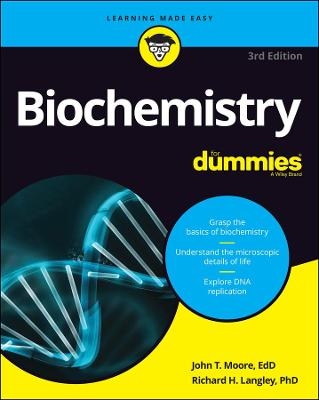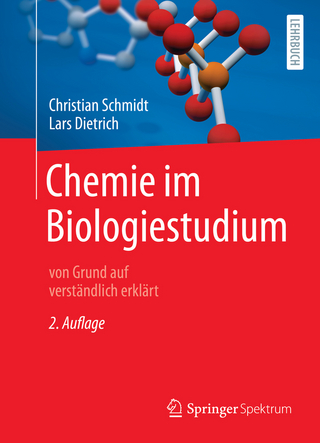
Biochemistry For Dummies
For Dummies (Verlag)
978-1-119-86095-2 (ISBN)
Biochemistry is the science of the chemical processes that allow for…well…life. If it moves, breathes, eats, or sleeps, biochemistry can probably explain how. So, it stands to reason that the fundamentals of biochemistry can get a little complicated.
In Biochemistry For Dummies, you’ll explore the carbons, proteins, and cellular systems that make up the biochemical processes that create and sustain life of all kinds. Perfect for students majoring in biology, chemistry, pre-med, health-services, and other science-related fields, this book tracks a typical college-level biochemistry class. It simplifies and clarifies the subject with easy-to-follow diagrams and real-world examples. You’ll also get:
Explorations of cell biology, carbohydrates, proteins, lipids, and other fundamental building blocks of life
Discussions of the basic structures common to all living organisms
Treatments of the microscopic details of life that make us all tick
If you’re looking for a hand with some of the trickier parts of biochemistry—or you just need an accessible overview of the subject—check out Biochemistry For Dummies today!
John T. Moore, EdD, and Richard H. Langley, PhD, teach Chemistry at Stephen F. Austin State University. Together they have more than 8.9 x 101 years of science education experience, and they have authored or coauthored oodles of books on chemistry topics.
Introduction 1
About This Book 1
Foolish Assumptions 2
Icons Used in This Book 3
Beyond the Book 3
Where to Go from Here 4
Part 1: Setting the Stage: Basic Biochemistry Concepts 5
Chapter 1: Biochemistry: What You Need to Know and Why 7
Why Biochemistry? 7
What Is Biochemistry and Where Does It Take Place? 8
Types of Living Cells 8
Prokaryotes 9
Eukaryotes 9
Animal Cells and How They Work 10
A Brief Look at Plant Cells 12
Chapter 2: Seems So Basic: Water Chemistry and pH 15
The Fundamentals of H2O 16
Let’s get wet! The physical properties of water 16
Water’s most important biochemical role: The solvent 18
Hydrogen Ion Concentration: Acids and Bases 20
Achieving equilibrium 20
Understanding the pH scale 21
Calculating pOH 23
Applying the Brønsted-Lowry theory 23
Buffers and pH Control 27
Identifying common physiological buffers 27
Calculating a buffer’s pH 28
Chapter 3: Fun with Carbon: Organic Chemistry 31
The Role of Carbon in the Study of Life 31
It’s All in the Numbers: Carbon Bonds 33
When Forces Attract: Bond Strengths 33
Everybody has ‘em: Intermolecular forces 34
Water-related interactions: Both the lovers and the haters 35
How bond strengths affect physical properties of substances 35
Getting a Reaction out of a Molecule: Functional Groups 37
Hydrocarbons 37
Functional groups with oxygen and sulfur 37
Functional groups containing nitrogen 38
Functional groups containing phosphorus 39
Reactions of functional groups 40
pH and functional groups 43
Same Content, Different Structure: Isomerism 44
Cis-trans isomers 44
Chiral carbons 44
Part 2: The Meat of Biochemistry: Proteins 47
Chapter 4: Amino Acids: The Building Blocks of Protein 49
General Properties of Amino Acids 50
Amino acids are positive and negative: The zwitterion formation 50
Protonated? pH and the isoelectric point 51
Asymmetry: Chiral amino acids 52
The Magic 20 Amino Acids 53
Nonpolar (hydrophobic) and uncharged amino acids 53
Polar (hydrophilic) and uncharged amino acids 55
Acidic amino acids 57
Basic amino acids 57
Lest We Forget: Rarer Amino Acids 58
Rudiments of Amino Acid Interactions 59
Intermolecular forces: How an amino acid interacts with other molecules 59
Altering interactions by changing the pH 61
Combining Amino Acids: How It Works 62
The peptide bond and the dipeptide 63
Tripeptide: Adding an amino acid to a dipeptide 64
Chapter 5: Protein Structure and Function 65
Proteins: Not Just for Dinner 65
Primary Structure: The Structure Level All Proteins Have 67
Building a protein: Outlining the process 67
Organizing the amino acids 68
Example: The primary structure of insulin 69
Secondary Structure: A Structure Level Most Proteins Have 69
The -helix 70
The -pleated sheet 71
-turns and the -loops 73
Tertiary Structure: A Structure Level Many Proteins Have 74
Quaternary Structure: A Structure Level Some Proteins Have 75
Dissecting a Protein for Study 75
Separating proteins within a cell and purifying them 75
Digging into the details: Uncovering a protein’s amino acid sequence 78
Chapter 6: Enzyme Kinetics: Getting There Faster 83
Enzyme Classification: The Best Catalyst for the Job 84
Up one, down one: Oxidoreductases 85
You don’t belong here: Transferases 86
Water does it again: Hydrolases 86
Taking it apart: Lyases 87
Shuffling the deck: Isomerases 87
Putting it together: Ligases 87
Enzymes as Catalysts: When Fast Is Not Fast Enough 88
All about Kinetics 90
Enzyme assays: Fixed time and kinetics 91
Rate determination: How fast is fast? 92
Measuring Enzyme Behavior: The Michaelis-Menten Equation 94
Ideal applications 97
Realistic applications 98
Here we go again: Lineweaver-Burk plots 98
Graphing kinetics data 100
Enzyme Inhibition: Slowing It Down 102
Competitive inhibition 102
Noncompetitive inhibition 103
Graphing inhibition 103
Enzyme Regulation 104
Part 3: Carbohydrates, Lipids, Nucleic Acids, and More, Oh My! 107
Chapter 7: What We Crave: Carbohydrates 109
Properties of Carbohydrates 110
They contain one or more chiral carbons 110
They have multiple chiral centers 111
A Sweet Topic: Monosaccharides 113
The most stable monosaccharide structures:
Pyranose and furanose forms 113
Chemical properties of monosaccharides 115
Derivatives of monosaccharides 117
The most common monosaccharides 119
The beginning of life: Ribose and deoxyribose 120
Sugars Joining Hands: Oligosaccharides 120
Keeping it simple: Disaccharides 121
Starch and cellulose: Polysaccharides 124
The Aldose Family of Sugars 126
Chapter 8: Lipids and Membranes 129
Lovely Lipids: An Overview 129
Behavior of lipids 130
Fatty acids in lipids 131
A Fatty Subject: Triglycerides 132
Properties and structures of fats 132
Cleaning up: Breaking down a triglyceride 134
No Simpletons Here: Complex Lipids 134
Phosphoglycerides 135
Sphingolipids 137
Sphingophospholipids 137
Membranes: The Bipolar and the Bilayer 138
Crossing the wall: Membrane transport 139
Steroids: Pumping up 142
Prostaglandins, Thromboxanes, and Leukotrienes: Mopping Up 143
Chapter 9: Nucleic Acids and the Code of Life 145
Nucleotides: The Guts of DNA and RNA 146
Reservoir of genetic info: Nitrogen bases 146
The sweet side of life: The sugars 146
The sour side of life: Phosphoric acid 148
Tracing the Process: From Nucleoside to Nucleotide to Nucleic Acid 148
First reaction: Nitrogen base + 5-carbon sugar = nucleoside 148
Second reaction: Phosphoric acid + nucleoside = nucleotide 149
Third reaction: Nucleotide becomes nucleic acid 150
A Primer on Nucleic Acids 151
DNA and RNA in the grand scheme of life 152
Nucleic acid structure 152
Chapter 10: Vitamins: Both Simple and Complex 155
More than One-a-Day: Basics of Vitamins 156
To B or Not to B: B Complex Vitamins 156
Vitamin B1 (thiamine) 157
Vitamin B2 (riboflavin) 158
Vitamin B3 (niacin) 159
Vitamin B6 (pyridoxine) 160
Biotin 160
Folic acid 162
Pantothenic acid 163
The wonders of vitamin B12 163
Vitamin A 164
Vitamin C 166
Vitamin D 166
Vitamin E 169
Vitamin K 169
Chapter 11: Hormones: The Body’s Messengers 171
Structures of Some Key Hormones 172
Proteins 172
Steroids 173
Amines 174
Now and Later: Prohormones 176
Proinsulin 176
Angiotensinogen 177
Fight or Flight: Hormone Function 177
Opening the letter: Hormonal action 178
Models of hormonal action 179
Part 4: Bioenergetics and Pathways 183
Chapter 12: Life and Energy 185
ATP: The Energy Pony Express 185
ATP and free energy 186
ATP as an energy transporter 187
It’s Relative: Molecules Related to ATP 190
The nucleoside triphosphate family 191
As easy as 1, 2, 3: AMP, ADP, and ATP 193
Where It All Comes From 193
Chapter 13: ATP: The Body’s Monetary System 197
Metabolism I: Glycolysis 198
Glycolysis: Phase I 198
Glycolysis: Phase II 201
Releasing the power: Energy efficiency 202
Going in reverse: Gluconeogenesis 202
Alcoholic fermentation: We’ll drink to that 202
Metabolism II: Citric Acid (Krebs) Cycle 204
Let’s get started: Synthesis of acetyl-CoA 208
Three’s a crowd: Tricarboxylic acids 208
Oxidative decarboxylation 209
Production of succinate and GTP 210
Oxaloacetate regeneration 210
Amino acids as energy sources 211
Electron Transport and Oxidative Phosphorylation 212
The electron transport system 213
Oxidative phosphorylation 218
Proposed mechanisms 221
ATP production 221
Involving the fats: β-oxidation cycle 222
Not so heavenly bodies: Ketone bodies 224
Investing in the Future: Biosynthesis 226
Fatty acids 226
Membrane lipids 229
Amino acids 231
Chapter 14: Smelly Biochemistry: Nitrogen in Biological Systems 237
Ring in the Nitrogen: Purine 237
Biosynthesis of purine 238
How much will it cost? 246
Pyrimidine Synthesis 247
First step: Carbamoyl phosphate 247
Next step: Orotate 247
Last step: Cytidine 250
Back to the Beginning: Catabolism 250
Nucleotide catabolism 251
Amino acid catabolism 251
Heme catabolism 252
Process of Elimination: The Urea Cycle 253
Amino Acids Once Again 256
Metabolic Disorders 257
Gout 257
Lesch-Nyhan syndrome 257
Albinism 258
Alkaptonuria 258
Phenylketonuria 258
Part 5: Genetics: Why We Are What We Are 259
Chapter 15: Photocopying DNA 261
Let’s Do It Again: Replication 262
DNA polymerases 265
The current model of DNA replication 265
Mechanisms of DNA repair 268
Mutation: The good, the bad, and the ugly 270
Restriction enzymes 272
Mendel Rolling Over: Recombinant DNA 272
Patterns: Determining DNA Sequences 273
Getting charged up about gel electrophoresis 274
Determining the base sequence 275
The butler did it: Forensic applications 277
Genetic Diseases and Other DNA Testing Applications 279
Sickle cell anemia 280
Hemochromatosis 280
Cystic fibrosis 280
Hemophilia 281
Tay-Sachs disease 282
Chapter 16: Transcribe This! RNA Transcription 283
Types of RNA 284
RNA Polymerase Requirements 285
Making RNA: The Basics 286
Promoting transcription of RNA 286
Prokaryotic cells 287
Eukaryotic cells 291
Not a Secret Any Longer: The Genetic Code 294
Codons 294
Alpha and omega 296
Models of Gene Regulation 297
The Jacob-Monod (operon) model 298
Regulation of eukaryotic genes 300
Chapter 17: Translation: Protein Synthesis 305
Hopefully Not Lost in Translation 305
Who needs translation, anyway? 305
Home, home in the ribosome 306
The Translation Team 307
The team captain: rRNA 307
Here’s the snap: mRNA 307
Carrying the ball: tRNA 308
Charging up the middle: Amino acid activation 310
Hooking Up: Protein Synthesis 312
Activation 313
Initiation 313
Elongation 314
Termination 315
The wobble hypothesis 315
Variation in Eukaryotic Cells 316
Ribosomes 316
Initiator-tRNA 318
Initiation 319
Elongation and termination 319
Part 6: The Part of Tens 321
Chapter 18: Ten Great Applications of Biochemistry 323
Ames Test 323
Pregnancy Testing 324
HIV Testing 324
Breast Cancer Testing 324
Prenatal Genetic Testing 324
PKU Screening 325
Genetically Modified Foods 325
Genetic Engineering 325
Cloning 326
Gene-Replacement Therapy 326
Chapter 19: Ten Biochemistry Careers 327
Research Assistant 327
Nanotechnologist 328
Quality Control Analyst 328
Clinical Research Associate 328
Technical Writer 329
Biochemical Development Engineer 329
Forensic Scientist 329
Patent Attorney 330
Pharmaceutical Sales Representative 330
Biostatistician 330
Index 331
| Erscheinungsdatum | 18.02.2022 |
|---|---|
| Sprache | englisch |
| Maße | 185 x 234 mm |
| Gewicht | 499 g |
| Themenwelt | Medizin / Pharmazie ► Medizinische Fachgebiete |
| Naturwissenschaften ► Biologie ► Biochemie | |
| ISBN-10 | 1-119-86095-4 / 1119860954 |
| ISBN-13 | 978-1-119-86095-2 / 9781119860952 |
| Zustand | Neuware |
| Informationen gemäß Produktsicherheitsverordnung (GPSR) | |
| Haben Sie eine Frage zum Produkt? |
aus dem Bereich


